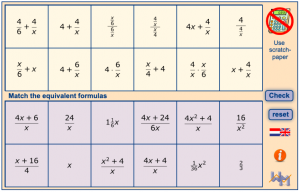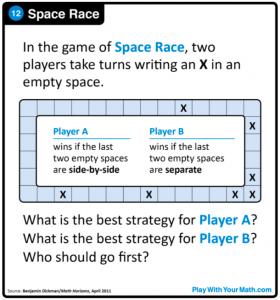One of my goals this summer was to try to clear some of my Twitter bookmarks, which go back to September 2020 (I am eagerly awaiting Twitter to come out with folders for better organization!). As I try to clear some of these bookmarks, I will share some of the ones that I found most interesting, beginning with those from September.
The first entry is from @Errs5, and he shared an open middle fraction division problem.
Any takers? @openmiddle @robertkaplinsky pic.twitter.com/bP0BGjoCJH
— MATHw/BRIAN (@Errs5) September 1, 2020
It looks like a good challenge, and so I have added it to my open middle saved problems. I am trying to build up my own open middle stack resource that aligns to my curriculum.
Then came a post from @wonderofscience on Theo Jansen’s Strandbeests. I had seen these years ago, but I am still mesmerized every time I watch the video.
His ‘beests” are created using plastic tubing and are energized through the wind. You can check out his website here.
I had saved a few tweets from Henk Reuling. I like this online matching applet, but be sure to check out all of his applets and activities (most open in English).

I had also bookmarked this post from @mathslinks, about Wheel of Names, a random generator. You can enter the names of each student in the class for random picking, and as a bonus…you can save your classes! I used it quite often last year and the students seemed to like it, as well.
Added to MathsLinks: Wheel of Names https://t.co/QIOyPBrhNf
— MathsLinks (@mathslinks) September 6, 2020
@MrNiksMathClass posted an interesting unit rate problem regarding the cost of paper towel.
We teach students the importance of unit rates when comparing prices of items. But, what if the item is paper towel? How would kids make price comparisons? Give this challenge and find out. Ask them to communicate their thinking behind every calculation. pic.twitter.com/VJGD3w0el8
— Math with P. Nik (@MrNiksMathClass) September 10, 2020
@howie_hua posted about the less known strategy of dividing across fractions (gasp!).
One of my joys in teaching is showing strategies that aren't really well-known. Today we talked about how we CAN divide across fractions like we can with fraction multiplication.
I also realized that I miss the audible gasps that I usually hear in in-person learning. pic.twitter.com/l5gQ5x5PY6
— Howie Hua (@howie_hua) September 23, 2020
If you want more of his awesomeness, check out his Tik Tok Math videos.
Shelby Strong (@Sneffleupagus) posted a link to a short movie titled, “A Boy and his Atom”. This is an IBM created stop motion movie made from…atoms. Her idea to tie it to scientific notation is great (but I will admit, something I forgot about when teaching it last year…better luck next year!).
@benjamindickman reminded me about the great Play with Your Math games and puzzles and shared an online version of Space Race created by the designer of Play with Your Math, @joeykelly89

If you need a hit of math jokes, then check this @GiftedTawk stream.
Math teachers: Hit me with your best “math joke” that I can share with my Ss tomorrow. Who infuses humor into their math instruction? Raise your hand.
— Julia's #STEAMing up Learning! (@GiftedTawk) September 17, 2020
@amyjhuckaby reminded me about Joseph’s Machines. I have shown some of his Rube Goldberg machines in my science class.
And for a somber end to this post, @ProfMarkMaslin tells the world that there are more Lego mini-people than real humans in this world….all made of single use plastic.
There are now more #Lego mini people than real people on Earth. This event horizon happened sometime between 2016-2018. And we are rapidly approaching 10 billion Lego people – and none of them are recyclable#PlasticPollution pic.twitter.com/k9DtPCsiCL
— Professor Mark Maslin (@ProfMarkMaslin) September 27, 2020

